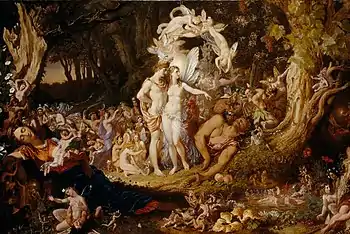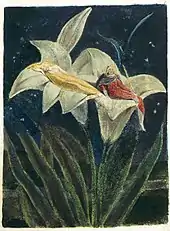Oberon
Oberon (/ˈoʊbərɒn/) is a king of the fairies in medieval and Renaissance literature. He is best known as a character in William Shakespeare's play A Midsummer Night's Dream, in which he is King of the Fairies and spouse of Titania, Queen of the Fairies.[1]

Merovingian legend
Oberon is derived from Alberich (from Old High German alb- "elf" and -rîh-, "ruler", "king"), a sorcerer in the legendary history of the Merovingian dynasty. He is referred to as the otherworldly "brother" of Merowech, whose name is the eponym of the Merovingians. Alberich wins for his eldest son, Walbert, the hand of a princess of Constantinople. In the Nibelungenlied, a Burgundian poem written around the turn of the 13th century, Alberich guards the treasure of the Nibelungen, but is overcome by Siegfried.
French heroic song
The name Oberon is first attested to in the early 13th century chanson de geste entitled Les Prouesses et faitz du noble Huon de Bordeaux, wherein it refers to an elven man of the forest encountered by the eponymous hero. Huon, son of Seguin count of Bordeaux, passed through the forest inhabited by Oberon. He was warned by a hermit not to speak to Oberon, but his courtesy had him answer Oberon's greetings and so gain his aid in his quest. Huon had murdered Charlot, the Emperor's son, in self-defense, and so he must visit the court of the amir of Babylon and perform various feats to win a pardon. He succeeds only with Oberon's aid.
This elf is dwarfish in height, though very handsome. He explains that, at his christening, an offended fairy cursed him to dwarfish height (an example of the wicked fairy godmother folklore motif) but relented and gave him great beauty as compensation. Alberich features as a dwarf in the Nibelungen; the dwarfish height was thus explained.[2]
The real Seguin was Count of Bordeaux under Louis the Pious in 839 and died fighting against the Normans in 845. Charles l'Enfant, a son of Charles the Bald, died in 866 of wounds inflicted by a certain Aubouin in the circumstances of an ambush similar to the Charlot of the story. Thus, Oberon appears in a 13th-century French courtly fantasy that is based on a shred of 9th century fact. He is given some Celtic trappings, such as a magical cup (similar to the Holy Grail or the cornucopia) that is ever full for the virtuous. "The magic cup supplied their evening meal; for such was its virtue that it afforded not only wine, but more solid fare when desired", according to Thomas Bulfinch. In this story, he is said to be the child of Morgan le Fay and Julius Caesar.
A manuscript of the romance in the city of Turin contains a prologue to the story of Huon de Bordeaux in the shape of a separate romance of Auberon and four sequels and there are later French versions as well.
Shakespeare saw or heard of the French heroic song through the c. 1540 translation of John Bourchier, Lord Berners, called Huon of Burdeuxe. In Philip Henslowe's diary, there is a note of a performance of a play Hewen of Burdocize on 28 December 1593.
A Midsummer Night's Dream

_(14729845086).jpg.webp)
In William Shakespeare's A Midsummer Night's Dream, written in 1595/96, Oberon is the king of all of the fairies and is engaged in a dispute with his wife Titania, the fairy queen. They are arguing over custody of a child whom Oberon wants to raise to be his henchman. Titania wants to keep and raise the child for the sake of her mortal friend and follower who died giving birth to him.
Because Oberon and Titania are both powerful spirits connected to nature, their feuding disrupts the weather. Titania describes the consequences of their fighting:
Therefore the winds, piping to us in vains,
As in revenge, have suck'd up from the sea
Contagious fogs; which falling in the land
Have every pelting river made so proud
That they have overborne their continents:
The ox hath therefore stretch'd his yoke in vain,
The ploughman lost his sweat, and the green corn
Hath rotted ere his youth attain'd a beard;
The fold stands empty in the drowned field,
And crows are fatted with the murrion flock;
The nine men's morris is fill'd up with mud,
And the quaint mazes in the wanton green
For lack of tread are undistinguishable:
The human mortals want their winter here;
No night is now with hymn or carol blest:
Therefore the moon, the governess of floods,
Pale in her anger, washes all the air,
That rheumatic diseases do abound:
And thorough this distemperature we see
The seasons alter: hoary-headed frosts
Far in the fresh lap of the crimson rose,
And on old Hiems' thin and icy crown
An odorous chaplet of sweet summer buds
Is, as in mockery, set: the spring, the summer,
The childing autumn, angry winter, change
Their wonted liveries, and the mazed world,
By their increase, now knows not which is which:
And this same progeny of evils comes
From our debate, from our dissension;
We are their parents and original.
Oberon tricks Titania into giving him back the child using the juice from a special flower that makes you "madly dote upon the next live thing that it sees". The flower was accidentally struck by Cupid's arrow when he attempted to shoot a young maiden in a field, instead infusing the flower with love. Oberon sends his servant, Puck, to fetch the flower, which he does successfully.
Furious that Titania will not give him the child, he puts juice from a magical flower into her eyes while she is asleep. The effect of the juice will cause Titania to fall in love with the first live thing she sees. Titania awakens and finds herself madly in love with Bottom, an actor from the rude mechanicals whose head was just transformed into that of a donkey, thanks to a curse from Puck.
Meanwhile, two couples have entered the forest: lovers Hermia and Lysander are pursued by Demetrius, who also loves Hermia, and Helena, who loves Demetrius. Oberon witnesses Demetrius rejecting Helena, admires her amorous determination, and decides to help her. He sends Puck to put some of the juice in Demetrius's eyes, describing him as “a youth in Athenian clothing”, to make him fall in love with Helena. Puck finds Lysander – who is also a youth wearing Athenian clothing – and puts the love potion on Lysander's eyes. When Lysander wakes, he sees Helena first and falls in love with her. Meanwhile, Demetrius has also been anointed with the flower and awakes to see Helena, pursued by Lysander, and a fight breaks out between the two young men. Oberon is furious with Puck and casts a sleeping spell on the forest, making Puck reverse the potion on Lysander, admonishing Puck to not reverse the effects on Demetrius. Both couples awake and begin the journey back to Athens.
Oberon now looks upon Titania and her lover, Bottom, and feels sorry for what he has done. He reverses the spell using a magic herb. When she wakes, she is confused, thinking that she had a dream. Oberon explains that the dream was real and the two reunite happily. They then return to Athens in the epilogue to bless the couples, becoming once again the benevolent fairy king and queen.
Other historical and cultural references
- Oberon is a character in The Scottish History of James IV, a play written c. 1590 by Robert Greene.
- In 1610, Ben Jonson wrote a masque of Oberon, the Faery Prince. It was performed by Henry Frederick Stuart, the Prince of Wales, at the English court on New Year's Day, 1611.
- Oberon is a main character in Michael Drayton's narrative poem Nimphidia (1627) about the fairy Pigwiggin's love for Queen Mab and the jealousy of King Oberon.
- In the anonymous book Robin Goodfellow, His Mad Pranks and Merry Jests (1628) Oberon is known as "Obreon" and is the father of the half-fairy Robin Goodfellow by a human woman.
- Christoph Martin Wieland first published his epic poem Oberon in 1780; it in turn became the basis (as indicated on the title page) for the German opera Huon and Amanda (Hüon und Amande in German), later known as Oberon, by Sophie Seyler. A plagiarized version of Seyler's opera[5] called Oberon by Karl Ludwig Giesecke with music by Paul Wranitzky debuted in Vienna shortly afterwards. Both operas enjoyed popularity. After extensive performances of the Giesecke version at the coronation of Leopold II in Frankfurt in 1791, it was much performed in Europe until it was surpassed in popularity by Weber's opera Oberon.
- Oberon and Titania are main characters in the 1789 Danish opera Holger Danske, with music by F.L.Æ. Kunzen and libretto by Jens Baggesen.
- Johann Wolfgang Goethe included the figures from Shakespeare's work in Faust I. Oberon is married to Titania, and the couple are celebrating their golden wedding anniversary in Faust I.
- In 1826, Carl Maria von Weber's opera, Oberon, (written after a poem by Christoph Martin Wieland translated to an English libretto by James Robinson Planche) debuted at Covent Garden in London, England.
- On January 11, 1787 William Herschel discovered both the outermost major satellite of Uranus, along its overall largest, and named them Oberon and Titania, respectively.
- Lucifer's Friend recorded the track "Thus Spoke Oberon" for the 1974 album Banquet.
- In 1984, the thrash metal band Metal Church released the album Metal Church, containing the song Metal Church. In the song, Oberon is alluded to as the god of heavy metal music.
- Oberon, usually accompanied by Titania, appears regularly in the Megami Tensei series.
- Roger Zelazny's Chronicles of Amber begins with Oberon as the missing father of Corwin, the main character. Corwin's brother and rival Eric has taken charge in his absence.
A fanciful etymology was given for the name Oberon by Charles Mackay in his book The Gaelic Etymology of the Languages of Western Europe along with many other theories on words found in the English language that have not found mainstream acceptance.[6][7]
References
- Rose, Carol (1996). "M". Spirits, Fairies, Leprechauns and Goblins: An Encyclopedia. New York: W.W. Norton. p. 207. ISBN 0-393-31792-7. OCLC 554956069.
- Katharine Briggs, An Encyclopedia of Fairies, Hobgoblins, Brownies, Boogies, and Other Supernatural Creatures, "Huon de Bordeaux", p. 227. ISBN 0-394-73467-X
- Morris Eaves; Robert N. Essick; Joseph Viscomi (eds.). "Description of " The Song of Los, copy B, object 5 (Bentley 5, Erdman 5, Keynes 5)"". William Blake Archive. Retrieved 27 January 2013.
- Morris Eaves; Robert N. Essick; Joseph Viscomi (eds.). "The Song of Los, copy B, object 5 (Bentley 5, Erdman 5, Keynes 5)". William Blake Archive. Retrieved 27 January 2013.
- Peter Branscombe, W. A. Mozart: Die Zauberflöte, Cambridge University Press, 1991, p. 28
- The author of Word Origins…And How We Know Them, Oxford University Press, 2005 and An Analytic Dictionary of English Etymology: An Introduction University Of Minnesota Press, 2008
- Oxford Etymologist
External links
- . Encyclopædia Britannica. 13 (11th ed.). 1911. p. 957.
- . Encyclopædia Britannica (11th ed.). 1911.
- The Gaelic Etymology of Western Europe, Charles McKay LL.D. 1877: "Oberon"